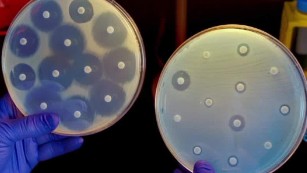The Los Angeles Times posted an article yesterday on “Deadly superbugs from hospitals get stronger in the sewers and could end up in the Pacific Ocean”. While there is some truth to the matter, it is necessary to approach it with some skepticism.
It is well known that antibiotic resistant bacteria are extremely prevalent in sewage systems, especially in biofilms (as mentioned in this past microbe.net post). First of all, the unusually high concentrations of many types of antibiotics create an environment for antibiotic resistant bugs. Additionally, bacteria can transfer antibiotic resistance to other microbes, so resistance doesn’t necessarily mean that a microbe has been exposed to the antibiotic it is resistant to. This makes sewage environments a critical site for the invention of superbugs.
So, back to this article. The fear is that hospital sewage containing CRE (carbapenem-resistant enterobacteriaceae) is not effectively sanitized by water treatment facilities. This means that superbugs can reenter the water supply and infect people that are otherwise outside of the hospital setting where CRE is found. Unfortunately, this is all theory; according to the article, “EPA scientists did not test treated wastewater flowing out of the plant to determine whether it still contained CRE.” This appears to be more of a knowledge gap than an outrageous claim. I have no doubt that the overlap of two big environments of superbugs (sewers and hospitals) is panic inducing.
Waste treatment facilities typically filter and chlorinate water, which superbugs and some chemicals can easily evade. Check out this old post about superbugs at these treatment facilities. Since reducing the use of antibiotics in today’s world is impossible anytime in the near future, it is time to think of alternatives to treating water. This is where I make my case for anaerobic digesters; a system I believe has a lot of promise. First of all, I think superbugs would have a really hard time surviving the anaerobic digestion process. There is an amazing amount of literature out there about using anaerobically digested manure on crops. Numerous studies show it doesn’t have a pathogen load (including antibiotic resistant bugs) compared to raw manure. An added bonus is we could harness the methane produced from the process as a renewable fuel!
Instead of changing and regulating the type of treatment plants use, the article suggests that it is time to have a regulatory agency to determine what hospitals are allowed to dump into our sewage systems. I don’t think this is all the necessary and would a big problem to deal with. Agricultural waste is also riddled with antibiotic resistant bugs and creates much more waste water than hospitals do.
What are your thoughts about this topic and/or about this article? Can you think of a viable solution to treating wastewater riddled with superbugs?

Regulating what hospitals are allowed to dump in our sewage systems is all well and good, but you cannot prevent patients who carry these organisms from using the toilet, both in the hospitals and in the community. Treating the waste is going to have to be the answer.